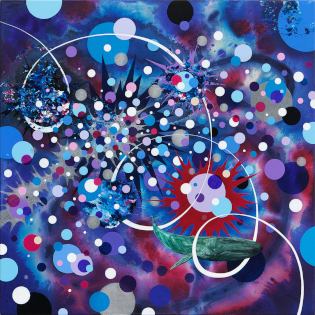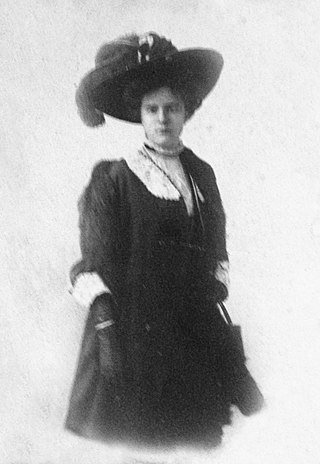
Magdalena Carmen Frida Kahlo y Calderón was a Mexican painter known for her many portraits, self-portraits, and works inspired by the nature and artifacts of Mexico. Inspired by the country's popular culture, she employed a naïve folk art style to explore questions of identity, postcolonialism, gender, class, and race in Mexican society. Her paintings often had strong autobiographical elements and mixed realism with fantasy. In addition to belonging to the post-revolutionary Mexicayotl movement, which sought to define a Mexican identity, Kahlo has been described as a surrealist or magical realist. She is also known for painting about her experience of chronic pain.

Jay DeFeo was an American visual artist who became celebrated in the 1950s as part of the spirited community of Beat artists, musicians, and poets in San Francisco. Best known for her monumental work The Rose, DeFeo produced courageously experimental works throughout her career, exhibiting what art critic Kenneth Baker called “fearlessness.”

Alice Neel was an American visual artist. Recognized for her paintings of friends, family, lovers, poets, artists, and strangers, Neel is considered one of the greatest American portraitists of the 20th century. Her career spanned from the 1920s to 1980s.

Margaret Leisha Kilgallen was a San Francisco Bay Area artist who combined graffiti art, painting, and installation art. Though a contemporary artist, her work showed a strong influence from folk art. She was considered a central figure in the Bay Area Mission School art movement.

Helen Lundeberg (1908–1999) was an American painter. Along with her husband Lorser Feitelson, she is credited with establishing the Post-Surrealist movement. Her artistic style changed over the course of her career, and has been described variously as Post-Surrealism, Hard-edge painting and Subjective Classicism.

Kara Maria, née Kara Maria Sloat, is a San Francisco-based visual artist known for paintings, works on paper and printmaking. Her vivid, multi-layered paintings have been described as collages or mash-ups of contemporary art vocabularies, fusing a wide range of abstract mark-making with Pop art strategies of realism, comic-book forms, and appropriation. Her work outwardly conveys a sense of playfulness and humor that gives way to explicit or subtle examinations—sometimes described as "cheerfully apocalyptic"—of issues including ecological collapse, diminishing biodiversity, military violence and the sexual exploitation of women. In a 2021 review, Squarecylinder critic Jaimie Baron wrote, "Maria’s paintings must be read as satires [that] recognize the absurdities of our era … These pretty, playful paintings are indictments, epitaphs-to-be."
Hosfelt Gallery in San Francisco, California was founded in 1996 by Todd Hosfelt to exhibit contemporary international artists working in all media.

Queena Stovall was an American folk artist. Sometimes called "The Grandma Moses of Virginia", she is famous for depicting everyday events in the lives of both white and black families in rural settings.

Deborah Remington was an American abstract painter. Her most notable work is characterized as Hard-edge painting abstraction.
Julie Chang is a San Francisco based contemporary artist who works primarily with painting and print making. Her work is influenced by textile design and patterns from various European and Asian cultures as well as pop cultural references. Ideas of identity and belonging are thematic throughout Chang's work.

Alice Brown Chittenden was an American painter based in San Francisco, California who specialized in flowers, portraits, and landscapes. Her life's work was a collection of botanicals depicting California wildflowers, for which she is renowned and received gold and silver medals at expositions. She taught at the Mark Hopkins Institute of Art from 1897 to 1941.
Dorothy Hood was an American painter in the Modernist tradition. Her work is held in private collections and at several museums, most notably the Museum of Modern Art and Museum of Fine Arts, Houston. Her preferred mediums were oil paint and ink.

Mary Heilmann is an American painter based in New York City and Bridgehampton, NY. She has had solo shows and travelling exhibitions at galleries such as 303 Gallery and Hauser & Wirth (Zurich) and museums including the Wexner Center for the Arts and the New Museum. Heilmann has been cited by many younger artists, particularly women, as an influential figure.

Melissa Miller is an American painter who is best known for what Art in America called "raucous allegorical paintings" of animals that balance storytelling, psychological insight and behavioral observation with technical virtuosity and formal rigor. She rose to prominence during a rebirth in figurative painting and narrative content in the early 1980s championed by curators such as Marcia Tucker and Barbara Rose, who both selected Miller for prominent surveys. Rose identified Miller among a group of iconoclastic "rule breakers," describing her work as "a wild kingdom … gone slightly berserk" in the struggle for survival, whose intensity recalled Delacroix. In a later Artforum review, Donald Kuspit called Miller's paintings "apocalyptic allegories" executed with meticulous old-master methods that articulated psychic states, existential problems and ecological concerns. Miller has exhibited at museums throughout the United States, including the Whitney Museum, New Museum, San Francisco Museum of Modern Art (SFMOMA), Museum of Fine Arts, Houston, and Hirshhorn Museum. Her work belongs to the public art collections of the Museum of Modern Art, National Museum of Women in the Arts, Albright-Knox Gallery and Museum of Fine Arts, Houston, among others, and she has received the Anonymous Was A Woman Award and Texas Artist of the Year Award. Miller lives and works in Austin, Texas.

Maria Porges is an American artist and writer based in the San Francisco Bay Area. As an artist she is known for the prominent use of text in her visual works, which encompass sculpture, works on paper and assemblage and have an epistemological bent. As a critic Porges has written for Artforum, Art in America, Sculpture and SquareCylinder, among other publications.

Sylvia Fein was an American surrealist painter and author. Inspired by the quattrocento, Fein painted in egg tempera, which she made herself. She studied painting at the University of Wisconsin–Madison, where she became part of a group of magical realist painters, including Gertrude Abercrombie, Marshall Glasier, John Wilde, Dudley Huppler, and Karl Priebe. A newspaper described her as "Wisconsin’s Foremost Woman Painter." Beginning in the 1940s, Fein lived for a time in Mexico, then in the San Francisco Bay Area of California, eventually settling in the town of Martinez. Her 100th birthday was marked with an exhibition at her alma mater, The University of California at Berkeley.

M. Louise Stanley is an American painter known for irreverent figurative work that combines myth and allegory, satire, autobiography, and social commentary. Writers such as curator Renny Pritikin situate her early-1970s work at the forefront of the "small, but potent" Bad Painting movement, so named for its "disregard for the niceties of conventional figurative painting." Stanley's paintings frequently focus on romantic fantasies and conflicts, social manners and taboos, gender politics, and lampoons of classical myths, portrayed through stylized figures, expressive color, frenetic compositions and slapstick humor. Art historians such as Whitney Chadwick place Stanley within a Bay Area narrative tradition that blended eclectic sources and personal styles in revolt against mid-century modernism; her work includes a feminist critique of contemporary life and art springing from personal experience and her early membership in the Women's Movement. Stanley has been awarded a Guggenheim Fellowship and grants from the Pollock-Krasner Foundation, Adolph and Esther Gottlieb Foundation, and National Endowment for the Arts. Her work has been shown at institutions including PS1, San Francisco Museum of Modern Art (SFMOMA), The New Museum and Long Beach Museum of Art, and belongs to public collections including SFMOMA, San Jose Museum of Art, Oakland Museum, and de Saisset Museum. Stanley lives and works in Emeryville, California.
Elizabeth Sawyer Norton (1887–1985) was an American artist, known for her bronze sculptures, paintings, and printmaking. The subject of her work often featured animals, landscapes and/or portraits. She lived in Palo Alto, California, from 1919 until her death in 1985.

Sybilla Mittell Weber (1892–1957) was an American artist known for her etchings and drypoints of dogs and horses. She was trained by an Austrian animal painter at the Academy of Fine Arts Munich and by an American etcher at the Art Students League. With the skills they taught her, she embarked on a long and successful career during which she employed traditional techniques to achieve results that drew consistent critical praise. Admired for her skill in animal portraiture and for her ability to portray animals in action, she was said to use an "economy of line" to achieve a style situated between the extremes of pure realism and pure abstraction.
Angelina Pwerle is an Australian Aboriginal artist. Her work is held by the Metropolitan Museum of Art, the National Gallery of Australia and other major institutions.


















